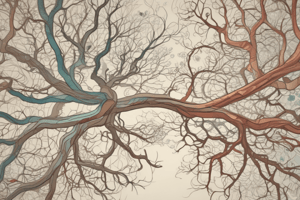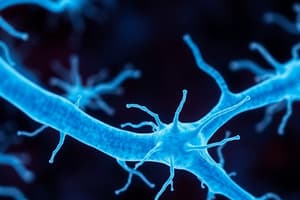Podcast
Questions and Answers
What are the primary components of the central nervous system (CNS)?
What are the primary components of the central nervous system (CNS)?
The primary components of the CNS are the brain and spinal cord.
Differentiate between the afferent and efferent divisions of the peripheral nervous system.
Differentiate between the afferent and efferent divisions of the peripheral nervous system.
The afferent division brings sensory information to the CNS from receptors, while the efferent division carries motor commands from the CNS to effectors.
Describe the role of neuroglia in the nervous system.
Describe the role of neuroglia in the nervous system.
Neuroglia cells support and protect neurons, preserving the physical and biochemical structure of neural tissue.
What is the function of dendrites in a neuron?
What is the function of dendrites in a neuron?
Explain the difference between sensory neurons and motor neurons.
Explain the difference between sensory neurons and motor neurons.
What classification of neuron is characterized by having one continuous process?
What classification of neuron is characterized by having one continuous process?
Identify the two types of neuroglia found in the peripheral nervous system (PNS) and their functions.
Identify the two types of neuroglia found in the peripheral nervous system (PNS) and their functions.
What is Wallerian degeneration and its significance in nerve injury?
What is Wallerian degeneration and its significance in nerve injury?
What are the five membrane processes involved in neural activity?
What are the five membrane processes involved in neural activity?
What is the significance of the synaptic cleft in neuron communication?
What is the significance of the synaptic cleft in neuron communication?
Flashcards are hidden until you start studying
Study Notes
Nervous System
- Consists of Central Nervous System (CNS) and Peripheral Nervous System (PNS)
- CNS includes brain and spinal cord, responsible for information processing and higher functions (intelligence, emotion, memory)
- PNS includes all neural tissue outside of CNS, responsible for transmission of electrical signals and sensory and motor information
Peripheral Nervous System (PNS)
- Afferent division: brings sensory information to CNS, receives input from receptors
- Efferent division: carries motor commands from CNS to effectors (targets), exits CNS
Neurons
- Receive and send signals
- Anatomy:
- Dendrites: bring information from environment to cell
- Cell body (soma): contains nucleus
- Axon: carries impulse away from soma
- Axolemma: plasma membrane of neuron
- Axoplasm: cytoplasm in axon
- Telodendria: extensions at end of axon
- Synaptic terminals: contain neurotransmitters
Synapse
- Specialized site of communication between neuron and another cell
- Pre-synaptic cell: sends message, contains neurotransmitters
- Post-synaptic cell: receives message, contains receptors for neurotransmitters
- Synaptic cleft: narrow space between cells
Classification of Neurons
- Anaxonic: brain and sense organs, all cell processes look alike
- Bipolar: special sensory organs (ear, eye, nose), 2 distinct processes
- Unipolar: axon and dendrites continuous, cell body off to one side, found in sensory neurons of PNS
- Multipolar: 2 or more dendrites and 1 axon, most common in CNS, all motor neurons controlling skeletal muscles
Sensory Receptors
- Relay stimuli to sensory neurons
- Interoceptors: monitor sensations from systems inside body (intero = inside)
- Exteroceptors: monitor sensations from external environment (extero = outside)
- Proprioceptors: monitor body position and movement of joints and muscles (proprio = one's own)
Functional Classification of Neurons
- Sensory neurons: afferent neurons of PNS, receive information from receptors and transmit to CNS
- Motor neurons: efferent neurons of PNS, carry motor commands from CNS to effectors
- Interneuron: association neurons, integrate sensory and motor information, involved in higher-order states (memory, planning, learning, cognition)
Neuroglia
- 4 types in CNS:
- Oligodendrocytes: myelinate CNS neurons
- Microglia: phagocytes that remove cell debris, wastes, and pathogens
- Ependymal cells: form epithelium to line ventricles and central canal, produce and circulate CSF
- Astrocytes: form 3D framework, regulate environment around neurons, and form blood-brain barrier
- 2 types in PNS:
- Satellite cells: regulate environment around cells
- Schwann cells: myelinate PNS neurons
Wallerian Degeneration and Repair
- Axon distal to injury site degenerates, macrophages clean up area
- Schwann cells proliferate and form solid cellular cord following path of axon, allowing for repair of damaged PNS nerves
- Limited repair in CNS due to scar tissue and chemicals blocking axon growth
Studying That Suits You
Use AI to generate personalized quizzes and flashcards to suit your learning preferences.




